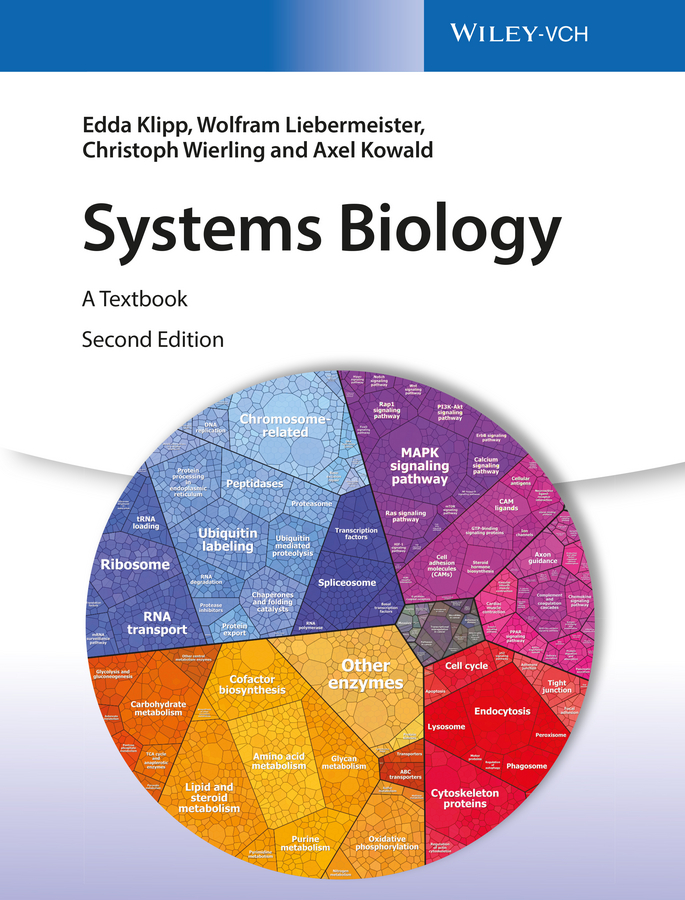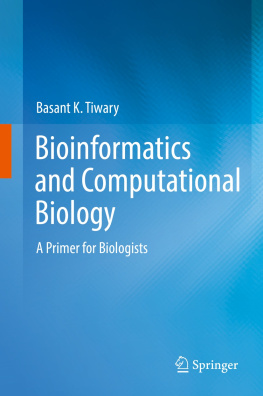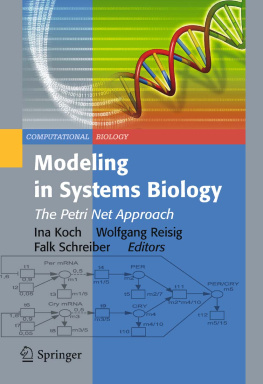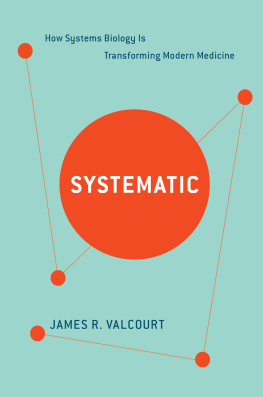Klipp Edda - Systems biology: a textbook
Here you can read online Klipp Edda - Systems biology: a textbook full text of the book (entire story) in english for free. Download pdf and epub, get meaning, cover and reviews about this ebook. City: Weinheim, year: 2016;2016, publisher: Wiley-VCH, genre: Home and family. Description of the work, (preface) as well as reviews are available. Best literature library LitArk.com created for fans of good reading and offers a wide selection of genres:
Romance novel
Science fiction
Adventure
Detective
Science
History
Home and family
Prose
Art
Politics
Computer
Non-fiction
Religion
Business
Children
Humor
Choose a favorite category and find really read worthwhile books. Enjoy immersion in the world of imagination, feel the emotions of the characters or learn something new for yourself, make an fascinating discovery.

- Book:Systems biology: a textbook
- Author:
- Publisher:Wiley-VCH
- Genre:
- Year:2016;2016
- City:Weinheim
- Rating:3 / 5
- Favourites:Add to favourites
- Your mark:
- 60
- 1
- 2
- 3
- 4
- 5
Systems biology: a textbook: summary, description and annotation
We offer to read an annotation, description, summary or preface (depends on what the author of the book "Systems biology: a textbook" wrote himself). If you haven't found the necessary information about the book — write in the comments, we will try to find it.
Systems biology: a textbook — read online for free the complete book (whole text) full work
Below is the text of the book, divided by pages. System saving the place of the last page read, allows you to conveniently read the book "Systems biology: a textbook" online for free, without having to search again every time where you left off. Put a bookmark, and you can go to the page where you finished reading at any time.
Font size:
Interval:
Bookmark:

All books published by Wiley-VCH are carefully produced. Nevertheless, authors, editors, and publisher do not warrant the information contained in these books, including this book, to be free of errors. Readers are advised to keep in mind that statements, data, illustrations, procedural details or other items may inadvertently be inaccurate.
Library of Congress Card No.: applied for
British Library Cataloguing-in-Publication Data
A catalogue record for this book is available from the British Library.
Bibliographic information published by the Deutsche Nationalbibliothek
The Deutsche Nationalbibliothek lists this publication in the Deutsche Nationalbibliografie; detailed bibliographic data are available on the Internet at .
2016 Wiley-VCH Verlag GmbH & Co. KGaA, Boschstr. 12, 69469 Weinheim, Germany
All rights reserved (including those of translation into other languages). No part of this book may be reproduced in any form by photoprinting, microfilm, or any other means nor transmitted or translated into a machine language without written permission from the publishers. Registered names, trademarks, etc. used in this book, even when not specifically marked as such, are not to be considered unprotected by law.
Print ISBN: 978-3-527-33636-4
ePDF ISBN: 978-3-527-67566-1
ePub ISBN: 978-3-527-67567-8
Mobi ISBN: 978-3-527-67568-5
Systems biology is the scientific discipline that studies the systemic properties and dynamic interactions in a biological object, be it a cell, an organism, a virus, or an infected host, in a qualitative and quantitative manner and by combining experimental studies with mathematical modeling. Scientists can describe the inner processes of stars a thousand light years away with great accuracy. But how a tiny cell under our microscope grows and divides remains puzzling in many ways. We see kids growing, people aging, plants blooming, and microbes degrading their remains. We use yeast for brewery and bakery, and doctors prescribe drugs to cure diseases. But do we understand how processes of life work?
Starting in the nineteenth century, such processes have no longer been explained by referring to special life forces, but by laws of physics and chemistry. By studying the structure and dynamics of living systems in finer and finer details, researchers from different disciplines have revealed how life processes arise from the structure and functional organization of cells, how tens of thousands of biochemical components interact in orchestrated ways, and how these systems are regulated by genetic information and continuously adapted through mutations and selection. With this conceptual shift, new questions became central in biology: How does an organism's phenotype emerge from the genotype, as encoded in the organism's DNA, and how is it shaped by environmental factors? Initially, such questions were approached by statistics, for example, by studying what mutations are associated with specific inheritable diseases. But the task, now, is to understand the mechanistic details.
We can easily understand the effects of gene disruptions when gene products have simple, specific functions. However, most gene mutations have only weak or quantitative effects on physiology, and many genetic diseases are multifactorial. Tracing the effects of multiple mutations, of mutations affecting gene regulation, or of drugs requires a deep, quantitative, and dynamical understanding of cell physiology. In recent years, high-throughput experiments, time series experiments, and imaging techniques with high resolution have provided us with a detailed picture of the cellular machinery. We can observe how physical structures are built, maintained, and reproduced, how the metabolic state is changing, and how signaling and regulation systems allow cells to adapt to their environment. However, to understand how all these systems act together and how cells can work as complex, robust systems cataloging and understanding single-cell components is not enough. Instead, we need to capture the global dynamics between these components. This is where mathematical models come into play.
Mathematical modeling has a long, though relatively marginal, tradition in biology, and has influenced the field in many ways. Models can be used to test hypotheses and to yield quantitative predictions or reveal gaps or inconsistencies in previous arguments, thus helping us to improve our understanding of biochemical processes. Inspired by the ideas of cybernetics in the sixties and seventies, dynamical systems theory and control theory have been increasingly applied to biochemical pathways. Thanks to powerful experimental techniques in genomics and proteomics, a wealth of biological data has accumulated and computational models of cells are now within reach. Systems biology, the discipline devoted to developing such models, uses biochemical networks as a main concept. It studies biological systems by investigating the network components and their interactions with the help of experimental high-throughput techniques and dedicated small-scale investigations and by integrating these data into networks and dynamical simulation models.
Like many new fields of research, systems biology started out with great expectations. High-throughput data and computational models were hoped to provide answers to basic yet difficult biological questions: Why do we age? What processes control cell proliferation, and how? How do neurodegenerative disorders or diseases such as cancer develop? How can we engineer microbes more efficiently to produce valuable chemicals, fuels, or specific drugs? Only few of these goals have been achieved until now, and most of these questions remain on our agenda. Nevertheless, systems biology has greatly contributed to our understanding of cells and is increasingly becoming a standard part of biological research. It has fostered the formulation of new concepts and methods, such as statistical network analysis, the analysis of the robustness and fragility of dynamical systems, and the analysis of molecular noise. Even more importantly, it has enabled experimental biologists to realize that some scientific ideas cannot be easily expressed by words only. Inspired by electrical engineering, biologists now communicate the structure of biochemical systems by network graphics, which can then be translated into dynamical models.
This book gives an overview of systems biology as a rapidly developing field and provides readers with established and emerging tools and methods. You will learn how to formulate mathematical models of biological processes, how to analyze them, how to use experimental data and other types of knowledge to make models more precise, and how to interpret their simulation results. Based on our own experiences in teaching undergraduate and graduate students, the book is designed as an introductory course for students of biology, biophysics, and bioinformatics. It is as well useful for senior scholars who approach systems biology for the first time or seek more information about specific concepts and techniques. In the first chapters, we introduce stoichiometric and kinetic models, the main theoretical frameworks for metabolism and signaling pathways. We continue with methods for model construction (including model fitting, data handling, and model reduction) and related formalisms (spatial, discrete, and stochastic models). Then, we move on to experimental high-throughput techniques and to cellular networks. The analysis of regulation networks leads us to more general perspectives on cell physiology, including modularity, robustness, and optimality. The main part of the book ends with a chapter on case studies. Addressing readers with different scientific backgrounds, we have added a reference section summarizing some basic knowledge of cell biology and mathematics, followed by a survey of popular biological databases and software tools. Further material is available on an accompanying Web site (http://www.wiley-vch.de/home/systemsbiology), which also contains solutions to the exercises presented in the book.
Next pageFont size:
Interval:
Bookmark:
Similar books «Systems biology: a textbook»
Look at similar books to Systems biology: a textbook. We have selected literature similar in name and meaning in the hope of providing readers with more options to find new, interesting, not yet read works.
Discussion, reviews of the book Systems biology: a textbook and just readers' own opinions. Leave your comments, write what you think about the work, its meaning or the main characters. Specify what exactly you liked and what you didn't like, and why you think so.









